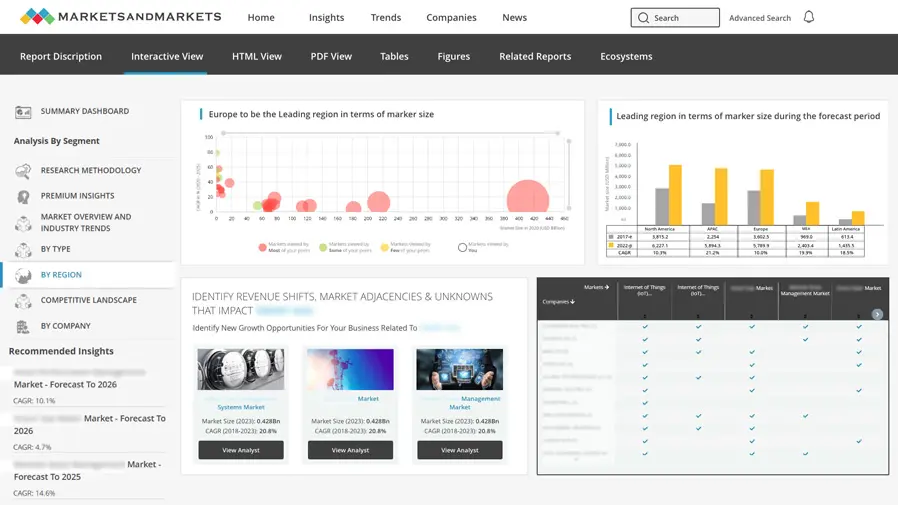Peripheral Component Interconnect Express Market by Generation (PCIe 1.0 & 2.0, PCIe 3.0, PCIe 4.0, PCIe 5.0, PCIe 6.0), Product (SLC, MLC), Form Factor(Mini PCle, Regular PCle), Application (Graphic Processor Units, Network Interface Cards, Storage Device & Controllers), End User (Telecommunication, Industrial, Residential, Datacenters, Automotive, Infrastructure, Others), Region (North America, Europe, Asia Pacific,RoW) - Global Forecast to 2030
PCIe, or Peripheral Component Interconnect Express, is a high-speed interface standard used for connecting various components in a computer, such as graphics cards, solid-state drives (SSDs), network cards, and more. It serves as the successor to older bus technologies like PCI and AGP, offering significantly faster data transfer rates and improved efficiency. PCIe uses a serial communication protocol, with data transmitted through lanes that consist of two pairs of wires—one for sending and one for receiving data. The number of lanes (e.g., x1, x4, x8, x16) determines the interface's bandwidth, with higher lane counts providing greater data throughput. Each lane acts independently, therefore devices of all different bandwidth capabilities coexist. PCIe is highly scalable, has backward compatibility across generations (i.e., 3.0, 4.0, 5.0), which improves the transfer rate and bandwidth of each subsequent generation. Being used widely among consumer, enterprise, and industrial applications, due to its diversity and reliability, the standard allows for advanced mechanisms in power management and error correction for stable operations. In modern computing, PCIe plays a critical role in enabling high-performance systems by connecting key hardware components with minimal latency.
Key Advantages of PCIe Market: Faster data transfer
PCIe (Peripheral Component Interconnect Express) is a high-speed interface that significantly enhances data transfer capabilities in modern computing systems. Its primary advantage is the ability to provide faster data transfer rates compared to older standards such as PCI or SATA. It achieves this with a scalable point-to-point architecture, allowing multiple lanes (x1, x4, x8, x16) to work in parallel, each lane delivering high bandwidth. This makes sure there is efficient communication between components like GPUs, SSDs, and network cards. It also reduces latency, so it is excellent for real-time data processing jobs. The standard is forward compatible; hence, further advancements will not require changing the whole infrastructure. PCIe supports high throughput as well, which is very important for data-intensive applications such as gaming, video editing, and AI workloads. Its direct connection to the CPU further optimizes data flow and enhances the performance of the entire system. As a result, PCIe has become a core component of contemporary high-performance computing.
Recent Trends in PCIe Market
The adoption of PCIe Gen 5 and Gen 6 is significantly driving the demand in the PCIe market, reflecting the growing need for higher performance and faster data transfer in computing and storage solutions. These new generations of PCIe technology deliver unprecedented bandwidth capabilities, with PCIe Gen 5 providing up to 32 GT/s and Gen 6 doubling that to 64 GT/s. This is an important increase in data throughput to support high-performance applications such as artificial intelligence, machine learning, big data analytics, and cloud computing. Enterprises are increasingly turning to PCIe Gen 5 and Gen 6 to enhance server performance, enable faster NVMe storage, and optimize GPU communication in data centers. Acceleration of adoption is also coming from industries such as autonomous vehicles and high-frequency trading, which require ultra-low latency and high-speed data handling. Further boosting market demand is the continuing ecosystem of new PCIe Gen 5 and Gen 6-qualified hardware, including but not limited to CPUs, GPUs, SSDs, and networking adapters. With these advancements, it helps organizations create a future-ready infrastructure while absorbing the exponential requirements of data in processing. These next-gen standards are therefore expected to rule the market and spur innovation across several sectors.
AI's Impact on PCIe Market
The growing use of Artificial Intelligence (AI) and Machine Learning (ML) is placing immense pressure on the existing compute infrastructure, particularly in terms of interconnect bandwidth. AI and ML workloads involve processing vast amounts of data quickly and efficiently, requiring high-speed data transfer between processors, GPUs, accelerators, and storage devices. This demand for faster and more efficient communication exceeds the capabilities of older PCIe standards. As a result, it is accelerating the adoption of newer PCIe generations, such as PCIe 5.0 and PCIe 6.0, which offer significantly higher bandwidth, reduced latency, and better energy efficiency. These advancements ensure that modern systems can meet the computational and data transfer needs of AI and ML applications effectively.
PCIe Market Dynamics
The PCIe (Peripheral Component Interconnect Express) market is shaped by rapidly evolving technological advancements and increasing demand for high-speed data transfer in computing, networking, and storage solutions. Key drivers include the growing adoption of cloud computing, artificial intelligence, and machine learning, which require robust and efficient interconnect technologies. The proliferation of data-intensive applications in industries like automotive, gaming, and IoT further fuels market growth. However, restraints such as high development costs, compatibility challenges with older systems, and limited expertise in advanced PCIe configurations pose hurdles. Opportunities lie in emerging trends like 5G deployment, edge computing, and the rise of NVMe storage solutions, which demand enhanced PCIe capabilities. Meanwhile, challenges include the need for standardized protocols, addressing thermal management issues, and ensuring security in high-speed data transmission. Innovations in PCIe Gen 5 and Gen 6 are expected to open new growth avenues, while competition from alternative interconnect technologies adds complexity to the market landscape. Industry collaborations and R&D investments are critical for sustaining momentum and overcoming barriers in this dynamic market.
Applications of PCIe Across Key Industries
The Peripheral Component Interconnect Express (PCIe) is a high-speed interface standard that is widely used across various industries because of its flexibility and performance. In the telecommunication industry, PCIe supports high-speed data processing and transmission in network switches, routers, and base stations to enable efficient handling of vast data flows in modern communication systems. Industrial applications require PCIe for real-time control systems, machine automation, and robotics applications, where its low latency and high bandwidth play a crucial role in the accuracy of operations. In residential and commercial data centres, PCIe makes up the basis of storage systems, GPUs, and high-performance computing clusters for faster data retrieval and processing on cloud computing and virtualization applications. The automotive industry also uses PCIe in advanced driver-assistance systems (ADAS), in-car infotainment, and electric vehicle control systems. These applications require high-speed data transfer to ensure smooth operations. PCIe is highly scalable, compatible, and reliable, making it a must in industries that demand robust and high-performance computing solutions.
















Growth opportunities and latent adjacency in Peripheral Component Interconnect Express Market